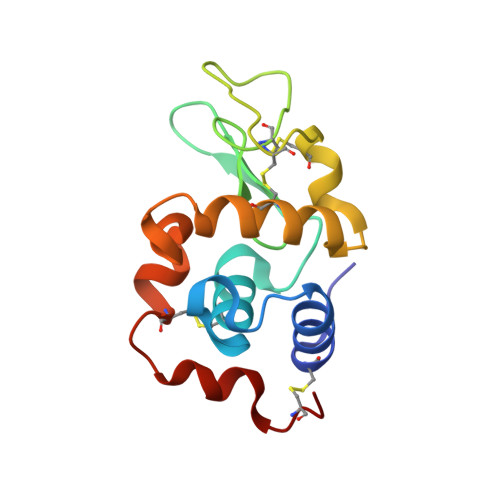Probing ion-binding at a protein interface: Modulation of protein properties by ionic liquids.
Han, Q., Su, Y., Smith, K.M., Binns, J., Drummond, C.J., Darmanin, C., Greaves, T.L.(2023) J Colloid Interface Sci 650: 1393-1405
- PubMed: 37480654
- DOI: https://doi.org/10.1016/j.jcis.2023.07.045
- Primary Citation of Related Structures:
7RXY, 7RYD, 7RYK, 7RZ0, 7RZ1, 7RZ2 - PubMed Abstract:
Ions are important to modulate protein properties, including solubility and stability, through specific ion effects. Ionic liquids (ILs) are designer salts with versatile ion combinations with great potential to control protein properties. Although protein-ion binding of common metals is well-known, the IL effect on proteins is not well understood. Here, we employ the model protein lysozyme in dilute and concentrated IL solutions to determine the specific ion binding effect on protein phase behaviour, activity, size and conformational change, aggregation and intermolecular interactions. A combination of spectroscopic techniques, activity assays, small-angle X-ray scattering, and crystallography highlights that ILs, particularly their anions, bind to specific sites in the protein hydration layer via polar contacts on charged, polar and aromatic residues. The specific ion binding can induce more flexible loop regions in lysozyme, while the ion binding in the bulk phase can be more dynamic in solution. Overall, the protein behaviour in ILs depends on the net effect of nonspecific interactions and specific ion binding. Compared to formate, the nitrate anion induced high protein solubility, low activity, elongated shape and aggregation, which is largely owing to its higher propensity for ion binding. These findings provide new insights into protein-IL binding interactions and using ILs to modulate protein properties.
Organizational Affiliation:
School of Science, STEM College, RMIT University, Melbourne, VIC 3000, Australia.
















